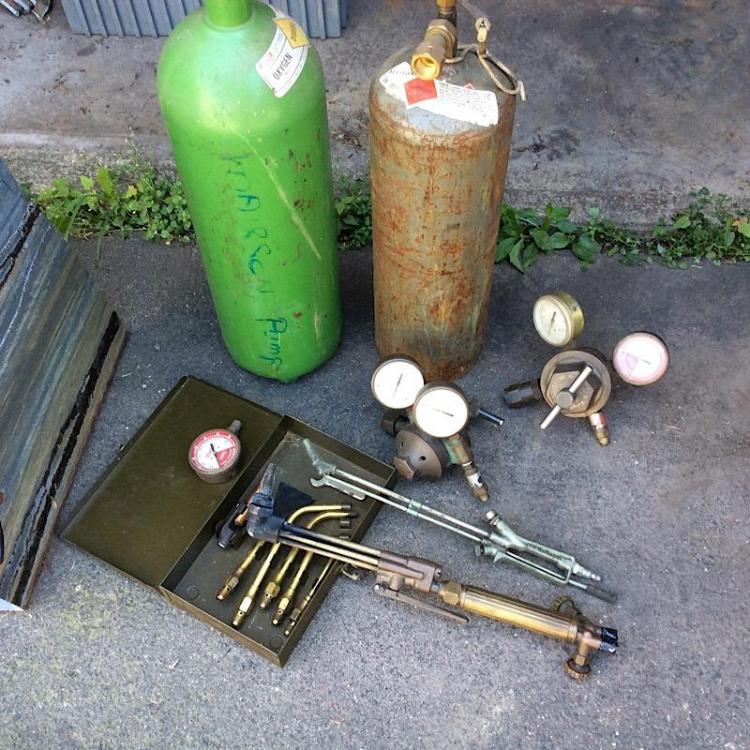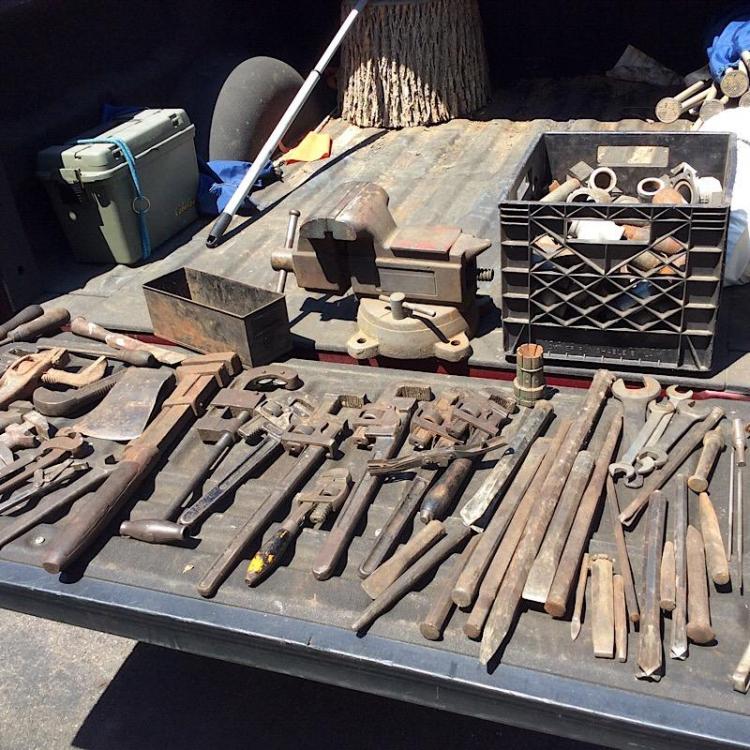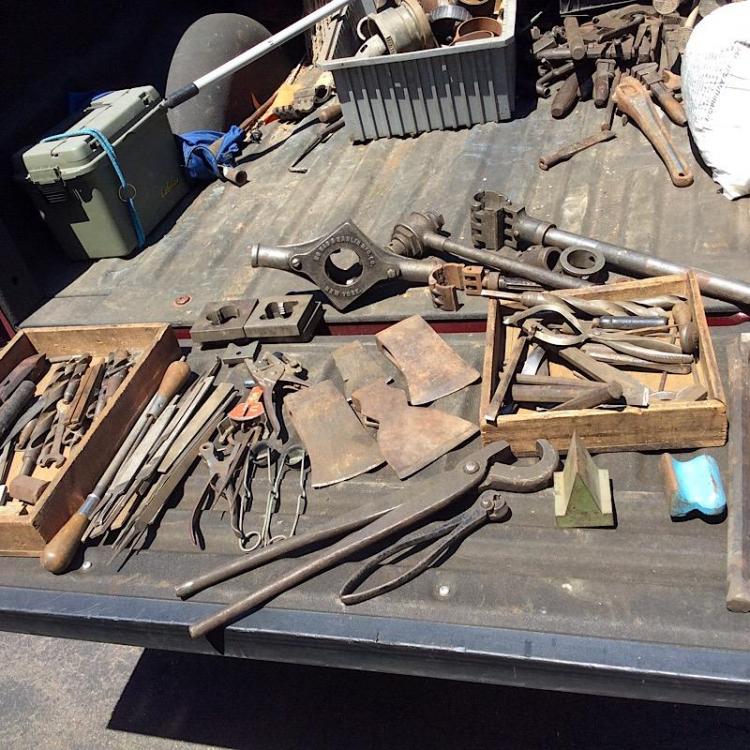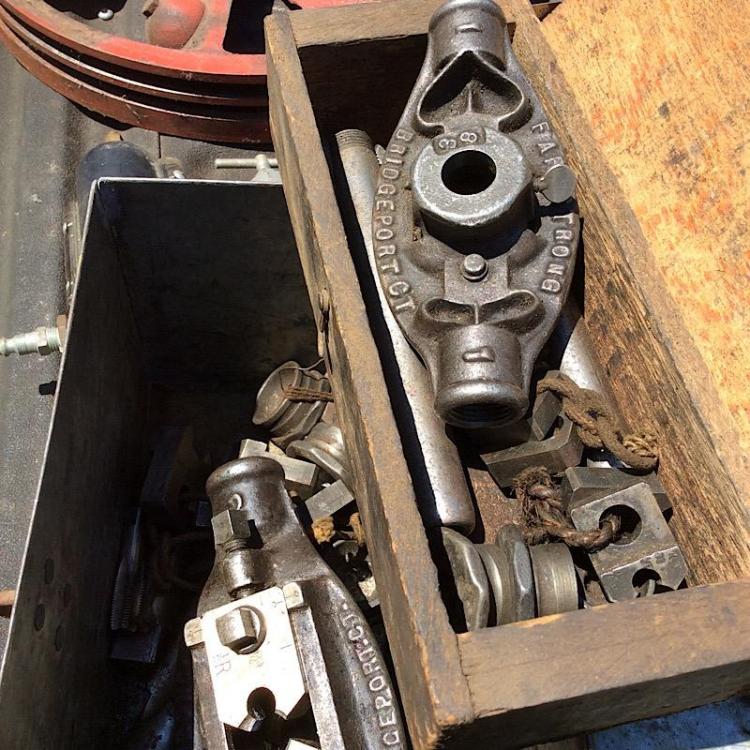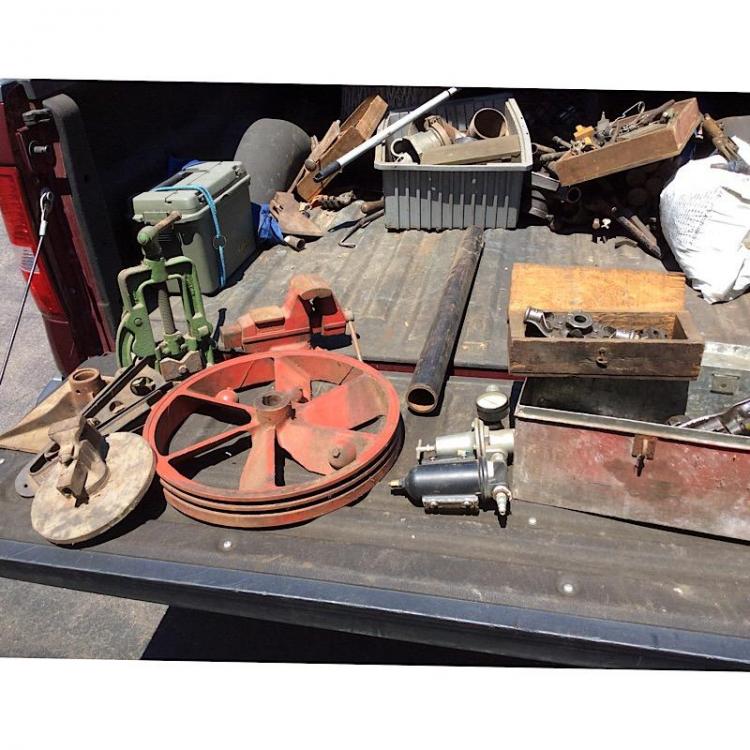-
Posts
1,180 -
Joined
-
Last visited
Content Type
Profiles
Forums
Articles
Gallery
Downloads
Events
Everything posted by Lou L
-
I’m honored! I hope they follow the firebrick road...
-
I went back to grab the leftovers from the father of a girl I coached and taught. I missed two small anvils that were given to elderly neighbors because they contained memories of his father that passed. Also missed out on a drill press and a bench grinder. But I think I did alright! Weird thing is, I was helping him out because he had no way to get rid of the stuff. I’m seriously going to need identification help for some of this stuff. Some I took out of curiosity, some out of need, and some just to do my part and help him get rid of junk. Without further blathering: There is so much stuff! And yes, it was all just given to me at the cost of lifting it. The fly wheel is grooved for two belts...it has the stink of power hammer on it but I think I’d be out of my depth trying to make one on my own right now. There were also two crates of pipe fittings from 1” to 4”. If you see something odd and can ID it for me feel free to do so. Lou
-
I just saw a video by John at Black Bear Forge and it is a brilliant tooling idea. Perhaps this is not new but I think it is worth sharing. I’ve included the screenshot of the video because it is informative of the content. The video is only about five minutes and he gives every detail you need to make your own. Lou
-
Welcome aboard. You would enjoy the green coal area at the Fall New England Blacksmiths meet. It’s in Mass. at Morrell Metalsmiths this year. Start reading and collecting!
-

Is this hatchet hand forged?
Lou L replied to Metal detector's topic in Axes, Hatchets, Hawks, Choppers, etc
It looks like it could be Colonial but I’m far from an expert. Plus, that style has been made continuously since then...I believe. I would fully assume it was hand forged because I don’t believe that style was made in production but I’m willing to be wrong. Im also a metal detector and would love to pull that out of the ground. I’m guessing it was one of those ugly sounding “rusty iron” hits that screams NAIL....but you just have to dig everything when you start out on a site. Better than yanking pull tabs out of the ground all day though! It would help to more knowledgeable folk who are bound to come along if you tell us about where in the world you found it. Location may help. How deep was it also? Foundations nearby? Known settlement? I always use the history of a site to get a preliminary date one what I find. Lou -
If galvanized wire lays in the dirt long enough it will rust. The fact that some parts are still shiny while others are cruddy tells me that it was once galvanized completely. Well, it doesn’t “tell” me that, but that’s what I would assume if it were mine to deal with. Cut the length you want, coil it up, and give it a vinegar bath anyway. Can’t hurt and might help even if there is no zinc. Have fun, Lou
-
I’m picturing a guy in shiny, baggy pants dancing side to side with a rusty band saw blade in his arms.
-
I still don’t understand how what JHCC said is any different from what the rest of us have said. There is a dearth of high school physics teachers right now in this county (they are so hard to find that incompetent ones are still treasured). The ramifications of this problem are becoming apparent. Steven, let me suggest an experiment (it can even be a thought experiment): Get a hammer and a piece of clay. Put the clay on top of a pillow that weighs two pounds and hit it with the hammer. Then put a two pound cut off from a two by four on the ground, put the clay on it, and hit it with the hammer. Then put ten pounds of solid wood on the ground, put the clay on it, and hit it with a hammer. You will see a difference between the pillow and the two pounds of wood because of the density of the pillow. You will see negligible difference between the two and ten pounds of wood. (Assuming your sw8ngs are similar). If you swing hard enough you may break the two pound piece of wood. The same swing won’t break the ten pound piece of wood. That is the major benefit of a big anvil.
-
Welcome aboard. Fair warning, the people on this site have no problem answering any question thrown their way, but they WILL let you know it when the answers are easily had on older threads because they’ve already been discussed at length. If you respect the amount of time some people here put in to answering questions and providing guidance then you will love it here. If you want quick answers and don’t intend to learn a little on your own the curmudgeons will rightfully get cranky! We are a big, happy, and terribly disfunctional family here on IFI. The amount on knowledge here on blacksmithing and essentially any topic you can dream up is mind blowing. Enjoy! Lou
-
Agreed, that’s a beauty. I want to use it. I like the combination of brut de forge with the hamon.
-

Material suggestion for different Mokume
Lou L replied to Aion27's topic in General Metal Specific Discussion
Thanks for the nickel idea, Wayne. That one I did not know. Now I’m thinking “nickels and oxy free copper sheet”. -
That is nice. It’s funny, I just posted a link to a video by John Bennet in the thread on reverse twists. He has a great jig for that purpose. However, he also does some videos on other interesting twists. He even did a very cool twist with angle iron.
-
Nice Trenton, Hawk! Yesterday I went to a graduation party for a girl I coached and taught. Her father told me that his father had passed a while ago and that he was giving away all the tools he owned. He brought me to the house (it was three minutes away) and SCORE. I am going with my truck to grab stuff in a couple days. There are a few bench vises, loads of large chisels, pipe threading tools, old wrenches, etc... I grabbed the handled top fuller that I found. I may get the oxy rig that was there as well. Will get a picture when I get to load the truck.
-
Agreed with all. Heat control is the key. I do my best to ensure that the steel is all the same color. I also use a very narrow old wrench that can grab the steel right at the point where the counter twist happens. There is another way, though, and it is brilliant! Check out this video by John Bennet. His jig is an excellent alternative. https://youtu.be/EQzk6ydsP6Y Lou
-

Purpose, Profit, or Potential?
Lou L replied to rockstar.esq's topic in The Business Side of Blacksmithing
I agree with you, basher, but I would maintain that, if one truly puts purpose first, profit and potential will find their way. This is idealistic, of course, because we all love the idea of working towards a great purpose; however, in reality we are all looking constantly over our shoulders with anxiety waiting for the profit and potential to be borne from our purpose. Which begs the question: In this world of present necessity, is it really possible to not put profit first....even when we are telling ourselves that it is our great purpose that drives us? I personally reconcile this conflict by managing my own definition of purpose. What type of effort provides personal meaning and satisfaction? If I have a selfish definition, one wherein I am fulfilled internally, then all is lost. However, if I find fulfillment in providing utility to others (service), I can have purpose in my work even when it is not the type of work I love to do. -
They help because of potential energy. They resist (and are able to return) more force than a smaller anvil can. But in reality, because most humans can’t even challenge a 150 pound anvil with the force of their hammer! there is very little benefit to a huge anvil. The benefits of a huge anvil in terms of moving metal are ridiculously small. The psychological benefits are different. Perhaps if you feel like your anvil is doing more work you will do more work? Who knows? I guess it can be simplified to this: If someone tells you larger anvils help you move more metal they are saying so because they spent a lot of money on a large anvil. As Das already said, there isn’t much you can’t do with a 127# anvil. There are other benefits to a large anvil,in terms of the size of the strik8ng area, the ability to support hardy tools, using strikers...etc...
-
A larger anvil provides more potential energy. Imagine crashing a car into a 6” diameter tree versus a 12” diameter tree. The car will absorb significantly more energy hitting the larger tree before that tree gives. When it come to anvils the difference is even less significant because a smith isn’t imparting enough force to benefit from the increased potential from the larger anvil. This changes when you use sledge hammers and strikers. In real use, the issue comes down to the anvil’s ability to handle the increased forces applied to it. Smaller anvils can be damaged by heavy striking. If you are working alone this really doesn’t affect you unless you are Hercules. I still want an anvil at least 100 pounds heavier than my 150# Isaac Hill and I’m not sure why....
-
This I didn’t not know....but I’m better for having learned it!
-
Nice! I’m hoping to get to use it some time when you,get you shop up and running. Hey it’s summer time, do you need any help with your shop! Seriously, once I get these knives done I’m available.
-
I use hard maple for my handles only because i have an absolute load of it. I just took a huge ash down in my yard and so, in a year or so, I’ll have even more ash. I still like the hard maple, it is seriously strong, tight grained, and still has some flex. I’m hoping to have the two big ash logs milled because they have awesome burls in them and may be desirable. Fork if ever handles my experience is limited to one handle. I used leopardwood because it was in the thickness I wanted and had really nice figuring. It was easily workable and hard. I haven’t put a finish on it because my friend I’m making the knives for wanted to do the final work on the handles.
-
I’m not sure where I learned it, but you can wipe your finger on the side of your nose and then use it to knock down the head on a beer. Too many years bartending and too many disgusted customers....
-
I’ve been struggling to figure out what metal to use to make some jewelry and there’s it is! Beautiful work and thanks for the idea Jclonts82. Lou
-
I would be tempted to turn chunk number one on its side and make inserts for various size holes for drifting. I think that the men in dark suits and sunglasses will be visiting you soon to collect chunk two! When I worked at Pratt & Whitney the Government was quite protective over the metals used in house. For some jobs they had the machinists gather and weigh the chips because the amount that goes out the door has to match the amount that came in. They use proprietary blends of metals.
-
Just stay away from galvanized steel. If you intend to weld any of it stick with 1/8” plate because, if you are like me, there is a high chance of accidentally burning through thin stuff. It sounds to me like you have a decent plan in mind and just need to go for it. Your anvil is cold, sad, and lonely and needs the comfort of glowing hot steel.

